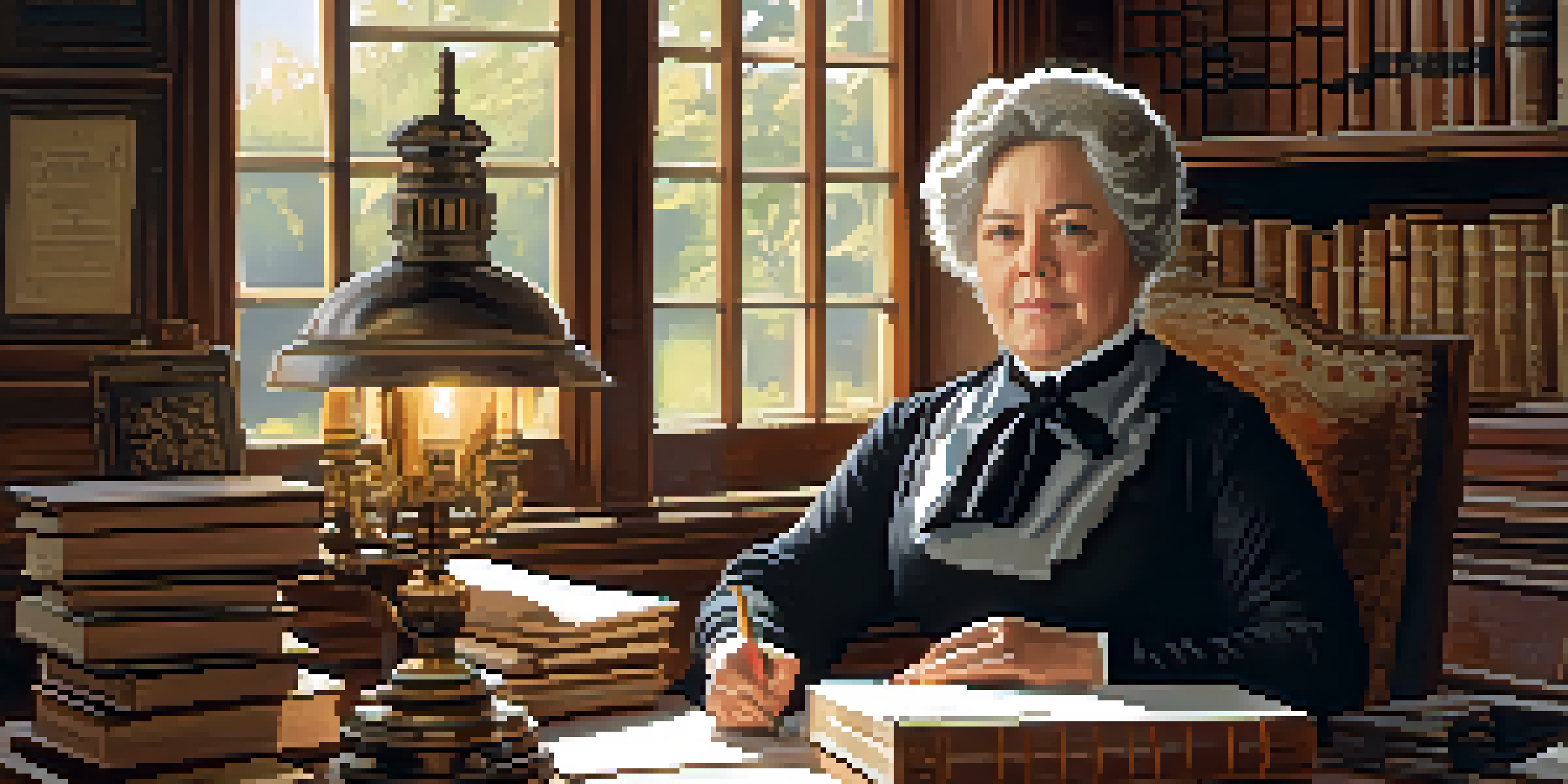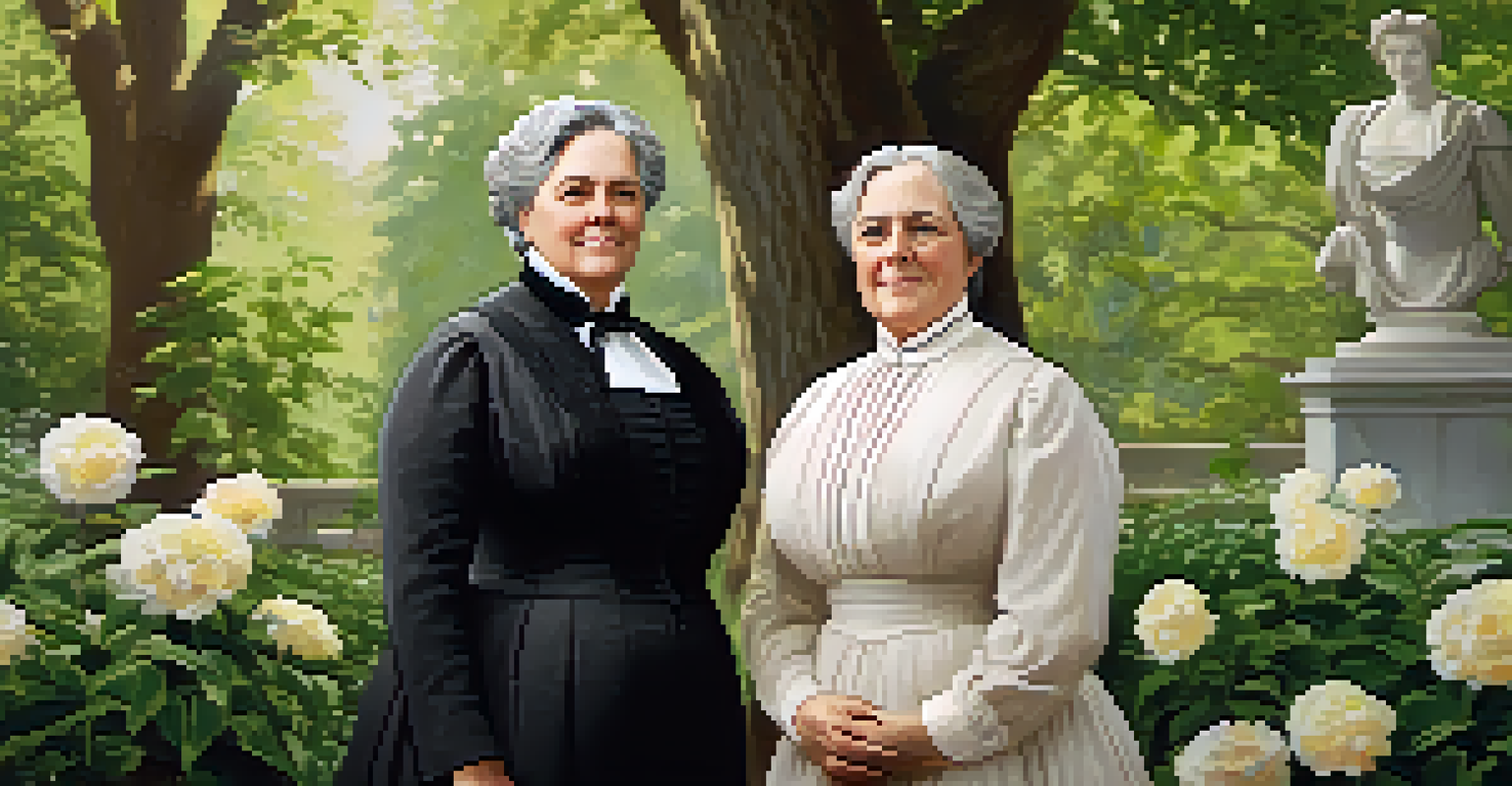Elizabeth Cady Stanton: A Pioneer in Women's Rights

Early Life and Influences of Elizabeth Cady Stanton
Born in 1815 in Johnstown, New York, Elizabeth Cady Stanton grew up in a household that valued education and independence. Her father, a prominent lawyer, often encouraged her to think critically, even when it came to the societal norms of her time. This early exposure to strong ideals of justice and equality shaped her views on women's rights, igniting a passion that would drive her throughout her life.
The best protection any woman can have... is courage.
Stanton's experiences as a young woman further fueled her commitment to social reform. After marrying Henry Stanton, she became increasingly aware of the limitations placed on women, especially in legal and political arenas. The birth of her seven children also deepened her understanding of women's roles and the need for change, as she often struggled to balance societal expectations with her desire for personal fulfillment.
These formative years laid the groundwork for her later activism, as Stanton began to recognize the systematic oppression that women faced. Her early experiences would not only influence her writings but also her future collaborations with other reformers, setting the stage for a lifetime of advocacy.
The Seneca Falls Convention: A Turning Point
In 1848, Stanton co-organized the Seneca Falls Convention, which marked a pivotal moment in the women's rights movement. This gathering was groundbreaking, bringing together activists and reformers to discuss the need for women's suffrage and other rights. Stanton's Declaration of Sentiments, which boldly echoed the language of the Declaration of Independence, demanded equality for women, making it clear that their voices could no longer be silenced.

The convention’s success laid the foundation for future women's rights gatherings, and it galvanized a generation of activists. Stanton's courage to address such controversial topics in a public forum was revolutionary, encouraging many women to join the fight for their rights. The event also highlighted the intersection of various social justice issues, demonstrating that the struggle for women's rights was part of a larger quest for equality.
Stanton's Early Influences
Elizabeth Cady Stanton's upbringing in a progressive household fueled her passion for women's rights and social reform.
Stanton's role at Seneca Falls was not just as a participant but as a leader who articulated the grievances of women everywhere. This event would become a model for future activism, showing that collective voices could indeed spark change and that women were ready to demand their rightful place in society.
Collaborations with Susan B. Anthony
One of the most significant partnerships in the women's rights movement was between Elizabeth Cady Stanton and Susan B. Anthony. Their friendship began in the early 1850s and blossomed into a powerful alliance that would drive the suffrage movement forward. Together, they complemented each other’s strengths: Stanton was the brilliant writer and thinker, while Anthony was a tireless organizer and speaker.
Men, their rights, and nothing more; women, their rights, and nothing less.
This duo traveled extensively, advocating for women's rights and suffrage, often facing backlash and ridicule. Despite the challenges, they remained undeterred, focusing on their shared goal of achieving equality for women. Their combined efforts led to the formation of the National Woman Suffrage Association, which became a crucial platform for advocating for women's voting rights.
Through their collaboration, Stanton and Anthony not only inspired countless women but also helped reshape the political landscape of their time. Their partnership exemplified the power of solidarity in social movements, proving that when individuals come together for a common cause, they can drive significant change.
Stanton's Advocacy for Broader Reforms
While Stanton is best known for her work in women's suffrage, her activism spanned a variety of social issues. She believed that women's rights were interconnected with other reform movements, including abolition and labor rights. This holistic approach emphasized that the fight for equality was not limited to one group but was a collective struggle against oppression in all its forms.
Stanton was particularly vocal about the need for women to have access to education and employment opportunities. She argued that financial independence was vital for women to achieve true equality in society. By advocating for reforms that addressed these broader issues, she sought to dismantle the systemic barriers that kept women from realizing their full potential.
Seneca Falls Convention Impact
The 1848 Seneca Falls Convention, co-organized by Stanton, marked a pivotal moment in the women's rights movement, demanding equality and suffrage.
Her writings and speeches often called for a reevaluation of societal norms regarding gender roles, urging both men and women to rethink their perspectives. This comprehensive view of social justice not only broadened the scope of the women's rights movement but also laid the groundwork for future generations of activists to tackle interconnected issues.
The Legacy of Elizabeth Cady Stanton
Elizabeth Cady Stanton's impact on the women's rights movement is profound and enduring. Her articulate advocacy and fearless leadership inspired generations of activists who continued the fight for women's suffrage and equality. By laying the groundwork for future movements, she ensured that the struggle for women's rights would persist long after her death in 1902.
Stanton’s writings, particularly her book 'The Woman's Bible,' challenged traditional interpretations of religious texts, arguing for a more equitable view of women’s roles in society. This work not only spurred discussions about women's rights within religious contexts but also encouraged many to reconsider their beliefs about gender equality.
Today, Stanton is remembered as a pioneering figure whose vision extended beyond her time. Her commitment to justice and equality resonates in contemporary movements, reminding us that the fight for women's rights is ongoing and that we all play a part in shaping a more equitable society.
Challenges and Controversies Faced by Stanton
Despite her significant contributions, Elizabeth Cady Stanton faced numerous challenges and controversies throughout her career. As a woman advocating for rights in a male-dominated society, she often encountered resistance from both men and women. Critics labeled her ideas radical, and she was sometimes met with hostility from those who feared losing their traditional roles.
Additionally, Stanton's views on race and her decision to prioritize women's suffrage over immediate abolition led to tensions within the broader abolitionist movement. Some activists felt that her approach marginalized the concerns of Black women and men, creating a rift that would have lasting implications. This aspect of her legacy serves as a reminder of the complexities within social movements and the importance of inclusivity.
Stanton's Early Influences
Elizabeth Cady Stanton's upbringing and education instilled in her a passion for justice and women's rights.
Despite these challenges, Stanton remained steadfast in her beliefs and continued to advocate for women's rights until her death. Her ability to navigate controversy while staying true to her vision showcases her resilience and dedication to the cause—a quality that continues to inspire modern activists today.
Continuing the Fight for Women's Rights Today
The legacy of Elizabeth Cady Stanton is evident in today's ongoing struggle for women's rights. Her pioneering work laid the foundation for subsequent movements that continue to advocate for gender equality in various spheres, including politics, education, and the workplace. Modern activists often draw inspiration from her courage and determination in pushing for change, demonstrating how her influence persists.
Today, issues that Stanton fought for, such as reproductive rights, equal pay, and combating gender-based violence, remain critical topics of discussion. The intersectionality of these issues highlights the importance of addressing women's rights within a broader context of social justice, echoing Stanton's own approach to activism. Her vision of a society where women are treated as equals is still a goal that many strive toward.

In celebrating Stanton's contributions, we are reminded of the ongoing need for activism and advocacy. As we reflect on her life and legacy, it becomes clear that the fight for women's rights is far from over, and each generation has a role to play in continuing this vital work.